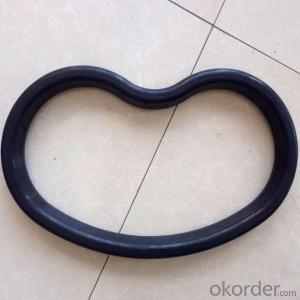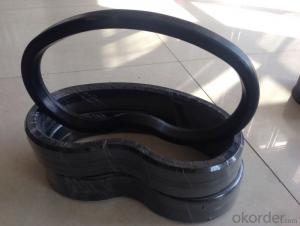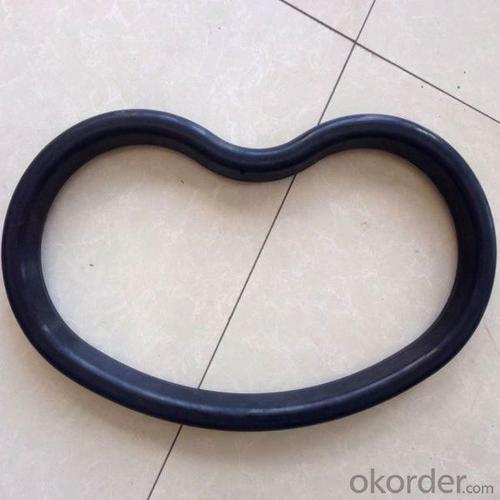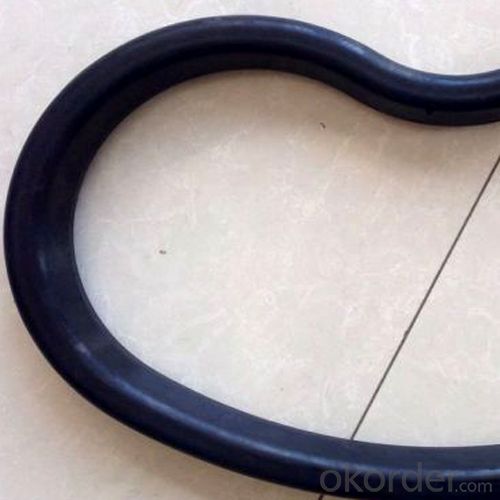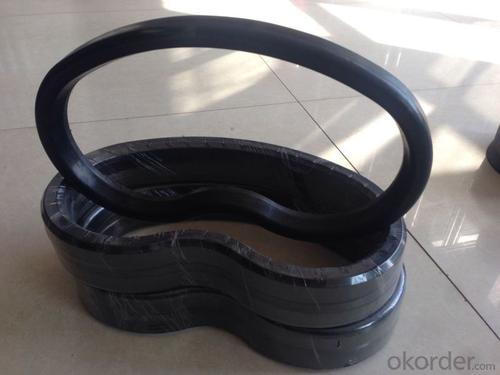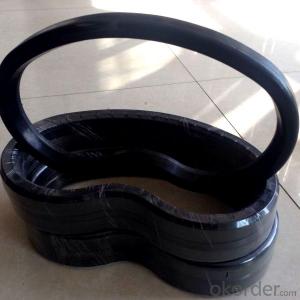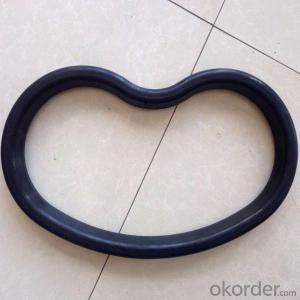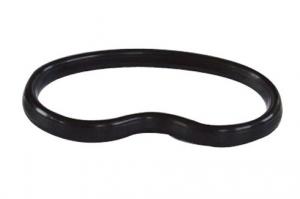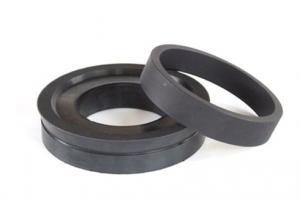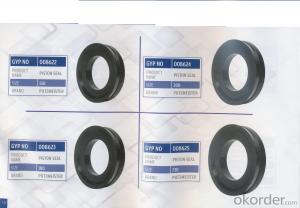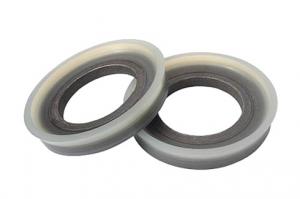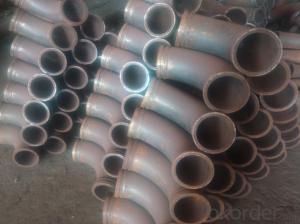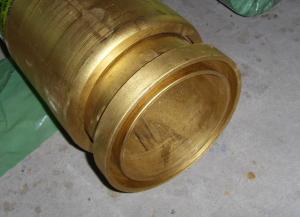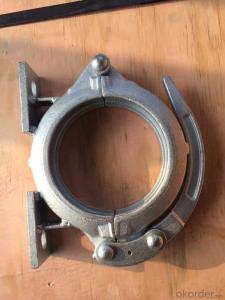Concrete Pumps Spare Parts Kidney Seal DN 180
- Loading Port:
- Tianjin
- Payment Terms:
- TT OR LC
- Min Order Qty:
- 10 pc
- Supply Capability:
- 1000 pc/month
OKorder Service Pledge
OKorder Financial Service
You Might Also Like
Product Description:
The Concrete Pumps Spare Parts Kidney Seal DN 180 normally made by special rubber materials, NR rubber and other rubbers to make sure the quanlity of seals according to customer’s requests, and also package in plywood box or cartons and put into container.
We are leading manufacturer of concrete pump wear parts in Beijing, China. Our products include wear plate&cutting ring, s valve, chrome bushing ,swing lever, wearing sleeve, spline shaft, pipe, elbow,clamp, rubber seal, delivery cylinders etc.
We are well noted the customer's needs and can offered the products by drawings from the customers, and also can manufacture according to customer request.
Scope of Application of the Goods
The Concrete Pumps Spare Parts Kidney Seal DN 180 is a concrete pumps parts for Schwing concrete pumps and truck pumps. The function of it mainly to sealing.
This seals can only be used for concrete stationary pumps and truckmounted pumps as well.
Product Advantages:
OKorder's Concrete Pumps Spare Parts Kidney Seal DN 180 Channels are durable, strong, and reliable. Our products has a qualified reputation from each customers from all over of the world.We have very good experience on middle east contries selling for this products, our suctomers happy with our seals for many years since we set up businesiness cooperations.
Main Product Features:
· Premium quality
· Prompt delivery & seaworthy packing (5-10 days)
Reliable performance
Easy to weld
High safety.
Specifications:
CNBM No. | 3000031 |
Original No. | 705422301050-2(10029138) |
Description | Kidney Seal DN 180 |
Remark |
FAQ:
Q1: How long about delivery time Concrete Pumps Spare Parts Kidney Seal DN 180 ?
A1: Normally we keep the stocks seals for our old customers to make sure delivery time in any emergency cases.
Q2: How do we guarantee the quality of our Concrete Pumps Spare Parts Kidney Seal DN 180 ?
A2: We have established an advanced quality control management system which conducts strict quality tests at every step, from raw materials to the final product. At the same time, we provide extensive follow-up service assurances as required.
Q3: How soon can we receive the product after purchase?
A3: Within three days of placing an order, the vessel will be booked for goods. The specific shipping date is dependent upon international and government factors, but is typically 7 to 30 workdays.
Q4: If we can produce some goods according to customers request?
A4: Yes, we can produce Kidney Seal DN 180 according to the difference country situations to make it suitable to the market and customers. We have very professional technical team to make the design for porduction of seals.
Q5: How to make a quick resolution for after service?
A5: OKorder and our manufacture both have overseas branches all-around of world.
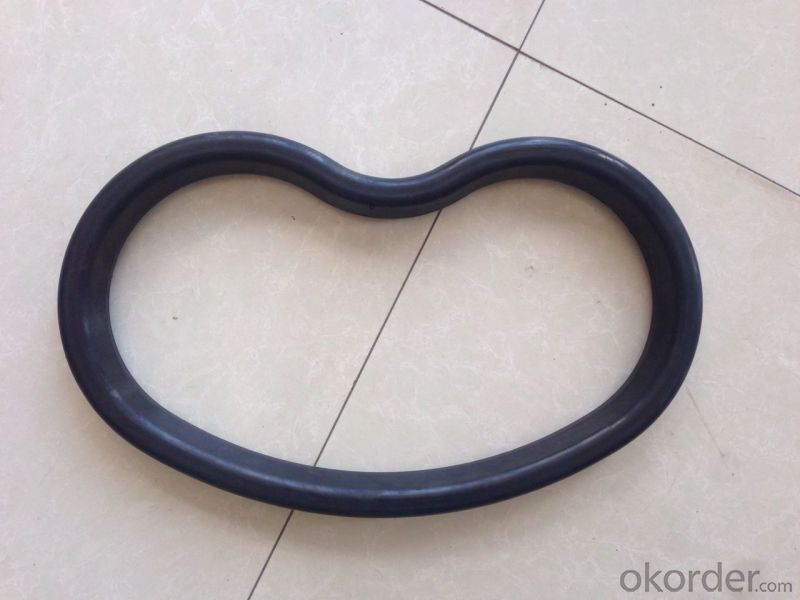

- Q: Are there any specific guidelines for the installation of wear plates or wear rings in concrete pump spare parts?
- Yes, there are specific guidelines for the installation of wear plates or wear rings in concrete pump spare parts. These guidelines ensure proper installation and optimal performance of the equipment. Here are some key guidelines to consider: 1. Inspection: Before installation, thoroughly inspect the wear plates or wear rings for any damage or defects. Any damaged or worn-out parts should be replaced to ensure efficient operation. 2. Cleanliness: Ensure that the concrete pump and all related components are clean and free from debris or contaminants. This will help prevent premature wear and extend the lifespan of the wear plates or wear rings. 3. Lubrication: Apply a suitable lubricant to the wear plates or wear rings before installation. This will help reduce friction and extend the service life of these components. 4. Alignment: Proper alignment is crucial for the effective functioning of wear plates or wear rings. Ensure that the plates or rings are aligned correctly and securely fixed in place. Misalignment can cause premature wear and damage to the equipment. 5. Tightening: Use the recommended torque specifications to tighten the bolts or fasteners that secure the wear plates or wear rings. Over-tightening or under-tightening can lead to improper functioning or damage to the equipment. 6. Regular Maintenance: Implement a regular maintenance schedule to inspect and replace worn-out wear plates or wear rings. Regular maintenance will help identify and address any issues before they lead to major breakdowns or costly repairs. It is important to consult the manufacturer's guidelines and follow their specific instructions for the installation of wear plates or wear rings in concrete pump spare parts. Adhering to these guidelines will ensure optimal performance and longevity of the equipment.
- Q: What are the different types of concrete pump hopper cylinders seals?
- There are several different types of concrete pump hopper cylinder seals, each designed to meet specific needs and requirements. Some of the most common types include: 1. Piston seals: These seals are designed to prevent leakage between the piston and cylinder bore. They are typically made of durable materials such as rubber or polyurethane, and are resistant to abrasion and wear. 2. Rod seals: Rod seals are installed on the piston rod to prevent leakage between the rod and cylinder head. They are often made of materials such as rubber or fabric-reinforced rubber, and provide reliable sealing even under high pressure conditions. 3. Wiper seals: Wiper seals are used to remove dirt, dust, and other contaminants from the piston rod as it retracts into the cylinder. They are typically made of polyurethane or rubber, and are designed to provide effective sealing and protection for the cylinder. 4. Wear rings: Wear rings are used to reduce friction and prevent metal-to-metal contact between the piston and cylinder bore. They are typically made of materials such as bronze or Teflon, and help to extend the lifespan of the cylinder by reducing wear and tear. 5. Backup rings: Backup rings are used in conjunction with other seals to provide additional support and stability. They are typically made of materials such as rubber or PTFE, and help to prevent extrusion and damage to the primary seal. Overall, the selection of the appropriate concrete pump hopper cylinder seal depends on factors such as the specific application, operating conditions, and desired performance characteristics. It is important to choose seals that are compatible with the pumped material, provide effective sealing, and have a long lifespan in order to ensure optimal performance and minimize maintenance requirements.
- Q: What is the role of a concrete pump seal?
- The role of a concrete pump seal is to prevent leakage and maintain the pressure within the pumping system. Concrete pumps are used to transfer liquid concrete from one location to another, typically from a mixer truck to a construction site. These pumps operate under high pressure to ensure the concrete flows smoothly through the pipeline. A concrete pump seal is a vital component that helps maintain the integrity of the pumping system. It is usually made of durable materials such as rubber or polyurethane, designed to withstand the high pressures and abrasive nature of concrete. The seal is located at the connection points between various sections of the pipeline, including the pump, pipeline joints, and hose connections. The primary function of the seal is to prevent concrete from leaking out of the system. Concrete is a viscous material, and any leakage can cause significant problems, such as a decrease in pumping efficiency, wastage of concrete, and potential damage to the surrounding environment. The seal ensures that the pumping system remains leak-free, allowing for efficient and continuous concrete transfer. Additionally, the seal helps maintain the required pressure within the pumping system. Concrete pumps rely on consistent pressure to ensure the concrete is delivered smoothly and evenly. Any pressure loss due to leakage can lead to uneven flow or blockages in the pipeline, affecting the overall performance of the pump. By sealing the connection points, the seal helps maintain the desired pressure, ensuring the concrete is pumped efficiently. Overall, the role of a concrete pump seal is to prevent leakage, maintain pressure, and ensure the smooth and efficient transfer of concrete from the source to the destination. It is an essential component that contributes to the overall effectiveness and reliability of concrete pumping operations.
- Q: What is the purpose of a concrete pump carbide wear plate?
- A concrete pump carbide wear plate serves the purpose of facilitating the transfer of concrete from the hopper to the desired location by providing a resilient and long-lasting surface. Concrete pumps utilize a piston system to propel the concrete through the pump and into the delivery line. Throughout this process, the wear plate acts as a safeguard against the abrasive nature of the concrete. Concrete comprises various components such as sand, gravel, cement, and water. When forced through the pump, the concrete's abrasive particles can inflict substantial damage on the pump's internal elements, leading to reduced efficiency and increased maintenance expenses. The carbide wear plate is specifically engineered to endure the elevated pressures and abrasive forces encountered during the concrete pumping procedure. Constructed from a robust and durable material known as carbide, this wear plate supplies a resilient surface that minimizes wear and tear on the pump's internal parts. By incorporating a concrete pump carbide wear plate, contractors and construction experts can ensure the efficient and effective operation of their concrete pumps, with minimal interruptions for repairs. This not only saves time and money but also guarantees that the concrete is transported smoothly and consistently to the desired location, resulting in high-quality construction projects.
- Q: How do I find the right part number for a specific concrete pump spare part?
- To find the right part number for a specific concrete pump spare part, there are a few steps you can follow: 1. Identify the specific part you need: First, determine the exact part you are looking for. This could be a specific component or a replacement part for a particular area of the concrete pump. 2. Consult the equipment manual: Check the equipment manual or documentation that came with the concrete pump. The manual often includes a parts list or diagram, which can help you identify the part number you need. 3. Contact the manufacturer or supplier: Reach out to the manufacturer or supplier of the concrete pump to inquire about the specific part you require. Provide them with the make, model, and serial number of the pump, as well as a detailed description or photograph of the part if possible. They should be able to provide you with the correct part number and any additional information you may need. 4. Use online resources: Utilize online resources such as manufacturer websites, spare parts catalogs, or specialized equipment platforms. These platforms often have search functions where you can input the make and model of the concrete pump to find the corresponding part numbers. 5. Seek assistance from industry experts: If you are still unable to find the right part number, consider reaching out to industry experts or professionals who specialize in concrete pump equipment. They may have the knowledge and experience to help you identify the correct part number based on your specific needs. Remember to double-check the part number provided by the manufacturer or supplier to ensure accuracy before making any purchases. Additionally, it is advisable to keep a record of the part number for future reference in case you need to reorder or replace the part again.
- Q: What is the role of a concrete pump hopper grate spring?
- The primary function of a concrete pump hopper grate spring is to offer tension and support to the hopper grate within a concrete pump. It is typically crafted from robust and flexible materials like steel or rubber, and its purpose is to securely hold the hopper grate in place while allowing for necessary movement and flexibility during the concrete pumping process. By preventing the hopper grate from becoming dislodged or damaged by the force and vibrations produced by the concrete pump, the hopper grate spring proves invaluable. It guarantees that the grate remains appropriately aligned and in its proper position, facilitating a smooth and efficient flow of concrete into the pump. Moreover, the grate spring lessens the impact and stress experienced by the hopper grate, thereby enhancing its lifespan and minimizing the requirement for frequent repairs or replacements. Acting as a buffer, it absorbs and distributes the substantial forces exerted on the grate due to the weight and pressure of the concrete being pumped. In conclusion, the concrete pump hopper grate spring plays a pivotal role in preserving the integrity and functionality of the hopper grate, thereby ensuring the safe and efficient operation of the concrete pump.
- Q: How do I troubleshoot issues related to concrete pump spare parts control systems?
- In order to troubleshoot issues related to concrete pump spare parts control systems, it is crucial to adopt a systematic approach. The following steps can be taken: 1. Clearly identify the problem: Start by precisely identifying the issue you are encountering with the control system. Is it completely non-functional? Are there specific functions or components that are not operating correctly? Understanding the problem will help guide your troubleshooting efforts. 2. Verify power supply: Make sure that the control system is receiving the appropriate power supply. Inspect the power source, circuit breakers, and fuses to ensure there are no interruptions or faults in the electrical supply. If necessary, replace or repair any faulty components. 3. Examine connections: Inspect the wiring connections and terminals within the control system. Loose or damaged connections can cause issues with the system's functioning. Tighten any loose connections and repair or replace any damaged wiring. 4. Review control settings: Confirm that the control settings are accurately adjusted according to the manufacturer's specifications. Incorrect settings can result in malfunctions or inefficient operation. Consult the user manual or contact the manufacturer for guidance on proper control settings. 5. Conduct diagnostic tests: Many control systems have built-in diagnostic features or error codes that can assist in identifying specific issues. Refer to the system's manual to understand how to access and interpret these diagnostic tools. Carry out any recommended diagnostic tests to pinpoint the problem area. 6. Inspect sensors and actuators: Sensors and actuators play a vital role in the operation of the control system. Check these components for any damage, misalignment, or malfunctioning. Clean or replace sensors as necessary and ensure that the actuators are properly connected and functioning correctly. 7. Seek technical support: If you have followed the aforementioned steps and are still unable to resolve the issue, it may be beneficial to contact the manufacturer's technical support team. They can offer expert guidance on troubleshooting the specific control system and may suggest additional steps or solutions. Always prioritize safety when troubleshooting control systems. Make sure that the pump is turned off and disconnected from the power source before working on any electrical components. If you are uncertain or uncomfortable with any troubleshooting steps, it is advisable to seek professional assistance.
- Q: Can concrete pump spare parts be purchased online?
- Indeed, online purchases of concrete pump spare parts are possible. Numerous online platforms and websites cater specifically to the sale of construction equipment and spare parts, including those for concrete pumps. These digital stores present a comprehensive assortment of options and brands, enabling customers to peruse and choose the precise spare parts required for their concrete pump. Moreover, online buying grants the convenience of price comparison, perusal of customer reviews, and doorstep delivery of the spare parts. Nevertheless, it remains imperative to ascertain the authenticity and dependability of the online store prior to making a purchase, guaranteeing the acquisition of genuine and top-notch spare parts.
- Q: How do I properly adjust and control flow rates in concrete pump spare parts?
- To properly adjust and control flow rates in concrete pump spare parts, there are a few key steps to follow: 1. Understand the equipment: Familiarize yourself with the specific concrete pump spare parts you are working with. Read the user manual and refer to any documentation provided by the manufacturer. This will help you gain a comprehensive understanding of the equipment's capabilities and how to adjust flow rates effectively. 2. Check the pump settings: Before starting any concrete pumping operation, ensure that the pump settings are properly configured. This includes checking the hydraulic pressure, engine RPM, and any other relevant settings. Make sure all valves and controls are in the correct position for the desired flow rate. 3. Monitor the pump speed: The speed of the pump directly affects the flow rate of the concrete. Different concrete mixtures may require different pump speeds to achieve the desired flow rate. Adjust the engine RPM accordingly, referring to the manufacturer's recommendations and any specific requirements for the project. 4. Adjust the pump stroke: Most concrete pumps have adjustable pump strokes to control the flow rate. By changing the length of the stroke, you can increase or decrease the volume of concrete being pumped. Experiment with different stroke lengths to find the optimal flow rate for your specific application. 5. Use the control panel: Many concrete pumps come equipped with a control panel that allows for precise adjustment of flow rates. Take advantage of these features to fine-tune the flow rate. Use the control panel to monitor the pump's performance and make any necessary adjustments to maintain a consistent flow. 6. Regularly inspect and maintain the equipment: Proper maintenance is crucial to ensure the accurate adjustment and control of flow rates. Regularly inspect the concrete pump spare parts for any signs of wear or damage. Clean and lubricate the components as recommended by the manufacturer. A well-maintained pump will operate more efficiently and provide more accurate control over flow rates. By following these steps, you can properly adjust and control flow rates in concrete pump spare parts. Remember to always prioritize safety and consult the manufacturer's instructions and guidelines for specific recommendations and considerations.
- Q: What is the purpose of a concrete pump control panel?
- The purpose of a concrete pump control panel is to provide operators with a centralized platform to control and monitor the various functions of a concrete pump. It allows them to adjust the pumping rate, control the direction and flow of the concrete, monitor the pressure levels, and ensure the safe and efficient operation of the machine.
Send your message to us
Concrete Pumps Spare Parts Kidney Seal DN 180
- Loading Port:
- Tianjin
- Payment Terms:
- TT OR LC
- Min Order Qty:
- 10 pc
- Supply Capability:
- 1000 pc/month
OKorder Service Pledge
OKorder Financial Service
Similar products
Hot products
Hot Searches
Related keywords
